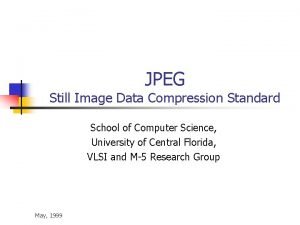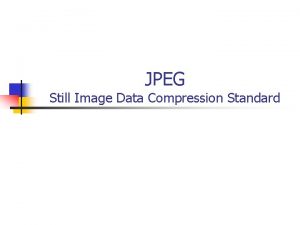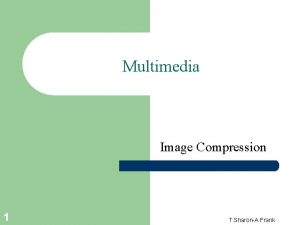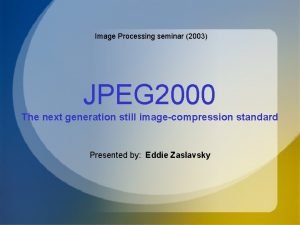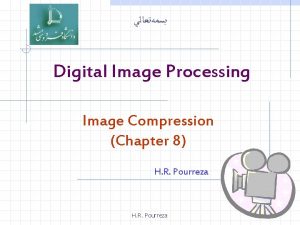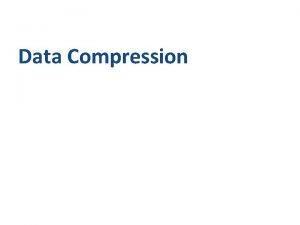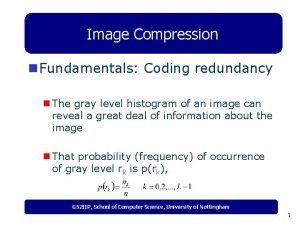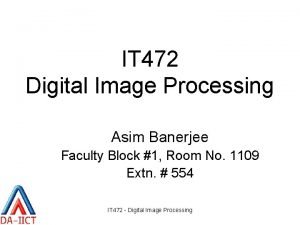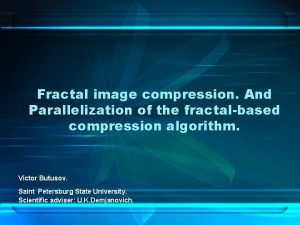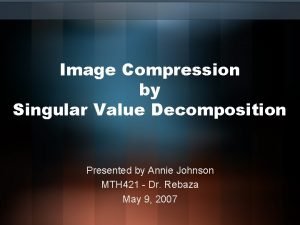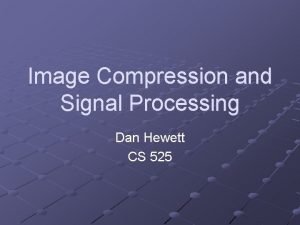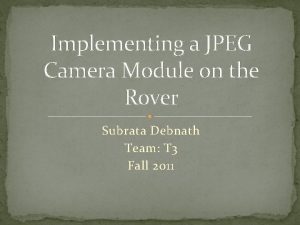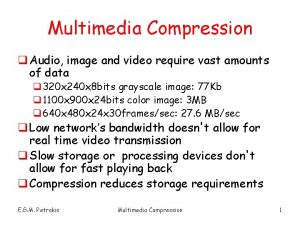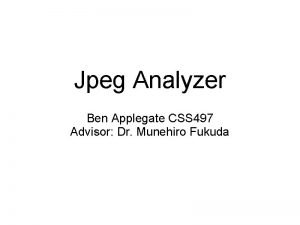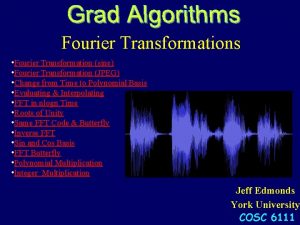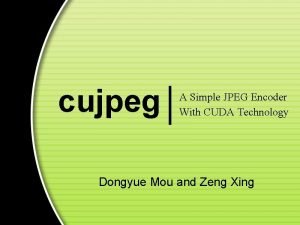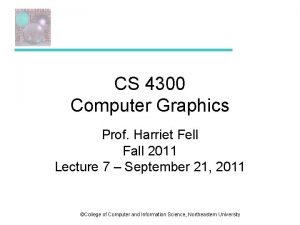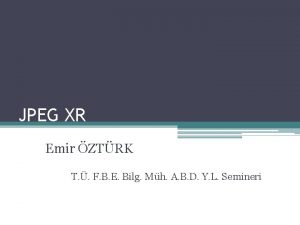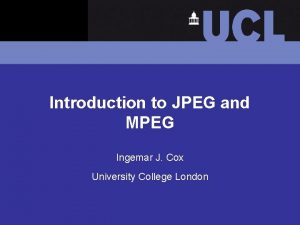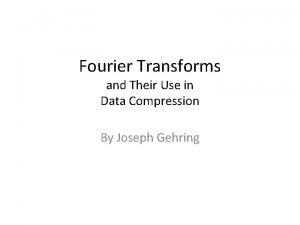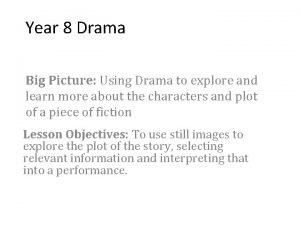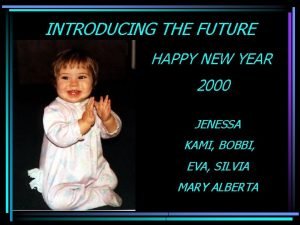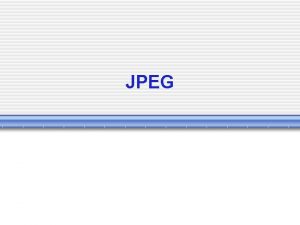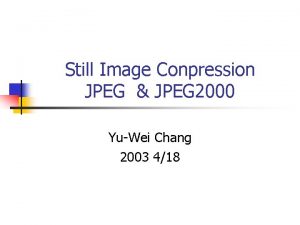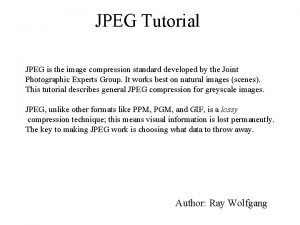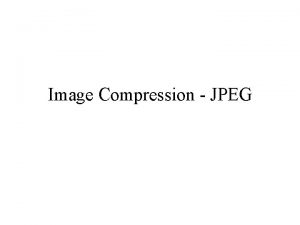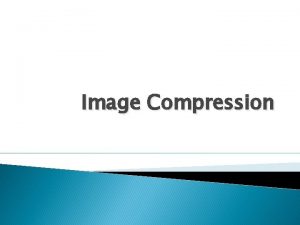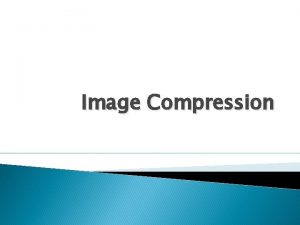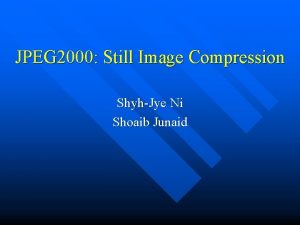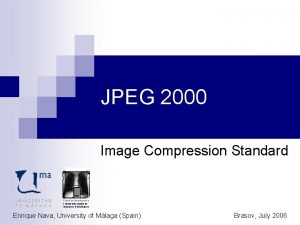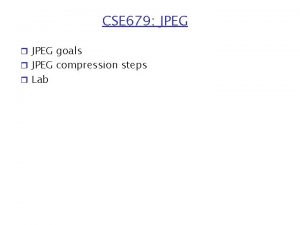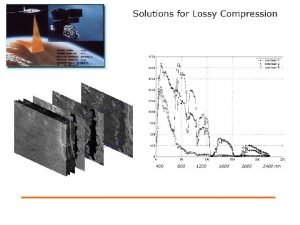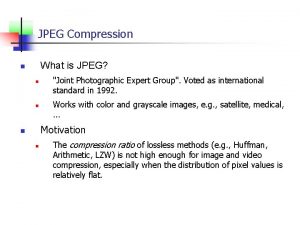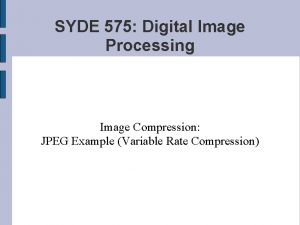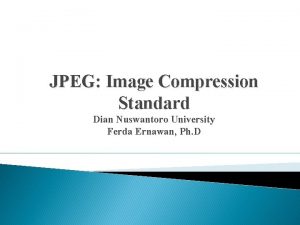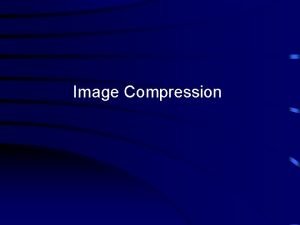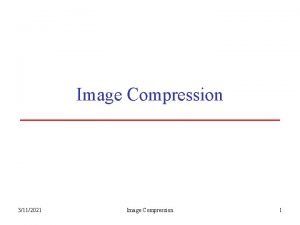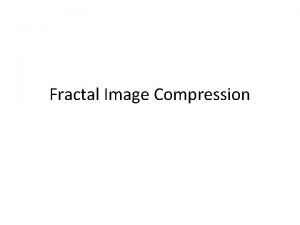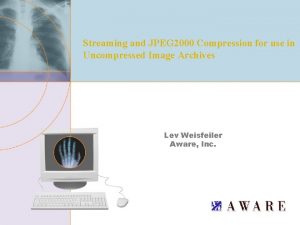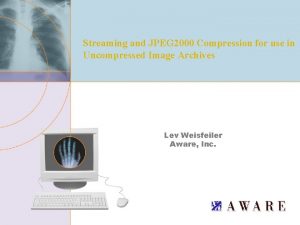JPEG 2000 New Standard for Still Image Compression
























































- Slides: 56

JPEG 2000: New Standard for Still Image Compression Tao Department of Computer Science University of Central Florida Some of the slides have been adopted from a presentation by Dr. T. Acharya 1

Outline • • • Introduction Part I JPEG 2000 Coding Region of Interest Bit-stream ordering Conclusion 2

Introduction 3

Why JPEG 2000 ? 5. 2 bpp los sy lossless Original image b it s t r e a m n regio Sub- Low er r eso 1. 84 bpp luti on RO I One component 1. 89 bpp 4

Why another still image compression standard? • To address a number of weakness in the existing JPEG standard. • To provide a number of new features that available in the JPEG standard. • Namely, – Allow efficient lossy and lossless compression within a single unified coding framework. – Provide superior image quality at low bit rates. – Support new features such as ROI and a more flexible file format. – Avoid excessive computational and memory complexity. 5

Why another still image compression standard (cont. )? – Larger image. JPEG does not allow for image greater than 64 k by 64 k without tiling – Transmission in noisy environment. JPEG image quality suffers dramatically when bit-errors are encountered. – Computer generated imagery. JPEG is optimized for natural imagery only. – Compound documents. JPEG is seldom used in the compression of compound documents because of its poor performance on bi-level (text) imagery. 6

7

8

9

10

11

12

13

14

15

16

17

18

JPEG 2000 Standard • • Part I : Core Coding System Part II : Extensions Part III : Motion JPEG 2000 Part IV : Conformance Testing Part V : Reference Software Part VI : Compound image file format More parts are coming… 19

Part I JPEG 2000 20

JPEG 2000 - Part I Rate Control Image Multi component transform Discrete Wavelet Quantization Transform Tier-1 Tier-2 Encoder Image encoder Reconstructed Image Inverse Multi component transform Inverse Wavelet Transform De-quantization Coded Tier-1 Tier-2 Decoder Coded Image decoder 21

JPEG 2000 Encoder Subbands tile Subband DWT Subband Image Component code block BPC Subband Code block Tile Context & Data Code block BAC Subband Compressed data Bit stream Layer formation and data formatting 22

Multi-Component Transform • Part I allows color transformation on first three components – Reversible Color Transform (RCT) – Irreversible Color Transform (ICT) Rate Control Image Multi component transform Discrete Wavelet Transform Quantization Tier-1 Encoder Tier-2 Encoder Coded Image Region of Interest 23

Irreversible Color Transform l The ICT is nothing more than the classic RGB-to-YCr. Cb color space transform. 24

Reversible Color Transform l The RCT is simply a reversible integer-tointeger approximation to the ICT 25

Discrete Wavelet Transform • DWT • Lifting Scheme Rate Control Image Multi component transform Discrete Wavelet Transform Quantization Tier-1 Encoder Tier-2 Encoder Coded Image Region of Interest 26

Quantization • Uniform scalar quantization with deadzone • No quantization in lossless mode • Quantization rule: Rate Control Image Multi component transform Discrete Wavelet Transform Quantization Region of Interest Tier-1 Encoder Tier-2 Encoder Coded Image 27

Deadzone Quantization l l Small coefficients increase the quality of the image the least, and they still mess up the run-length encoding as much as big coefficients. A deadzone quantizer blocks the small coefficients 28

Entropy Coding • Tier-1 coding – Bit Plane Coding (BPC) • Tier-2 coding – Tag Tree Coding Rate Control Image Multi component transform Discrete Wavelet Transform Quantization Tier-1 Encoder Tier-2 Encoder Coded Image Region of Interest 29

Tier-1 Coding • Tier-1 coding is performed on code blocks • For each bit plane, there are 3 coding passes, similar to those in EZW or SPIHT: – Significance Pass (a/(a+r)) – Refinement Pass (a/(a+r)) – Clean Up Pass (a) Example of scan pattern for a 10 x 5 code block 30

Tier-1 Coding (cont. ) Sign-Magnitude Representation Samples in a code block Sign 0 0 1 0 0 4 10 2 11 -1 13 15 4 0 9 -5 14 7 8 -15 3 4 10 2 11 Magnitude 1 4 5 8 13 15 0 9 14 7 15 3 31

Tier-1 Coding (cont. ) • • • Significance Each sample in the code-block has an associated binary state variable called its significance. A sample is significant if it is larger than the current bit plane. A sample is predicted to be significant if any of its 8 -connected neighbor has been found to be significant ‘Significances” are initialized to 0 and may become 1 during the course of the coding of the code-block. Once the significance for a sample becomes 1, it stays 1 throughout the encoding of the code block. : 7 binary format: 0111 Example 32

Tier-1 Coding (cont. ) Significance Pass 33

Tier-1 Coding (cont. ) Refinement Pass 34

Tier-1 Coding (cont. ) Cleanup Pass 35

Example of Tier-1 Coding 36

Original image 37

2. 5 bpp with 4 Level DWT 38

3. 5 bpp with 4 Level DWT 39

Compressed at 4. 9 bpp with 4 level DWT 40

Region Of Interest 41

l DWT ROI mask coefficients contributes only to a specific region. l A binary mask generated in the wavelet domain for distinction of ROI and Background 42

Original image 43

ROI Example (encoded at 5. 85 bpp) 44

Difference image (d > 5) 45

Bit-stream Ordering 46

2 level DWT with 16 Code Blocks 2 LL 2 HL (CB 1) (CB 2) 2 LH 2 HH (CB 3) (CB 4) (CB 9) (CB 10) 1 LH (CB 11) (CB 5) (CB 6) 1 HL (CB 7) (CB 8) (CB 13) (CB 14) 1 HH (CB 12) (CB 15) (CB 16) 47

Assume maximum 4 Bit Planes for each Code Block BP 4 C C C C BP 3 S M C S M C S M C S M C BP 2 S M C S M C S M C S M C BP 1 S M C S M C S M C S M C CB 19 CB 11 CB 12 CB 13 CB 14 CB 15 CB 16 CB 1 CB 2 CB 3 CB 4 2 LL 2 HL 2 LH 2 HH CB 5 CB 6 CB 7 1 HL CB 8 CB 9 1 LH 1 HH S : Significance propagation pass M : Magnitude refinement pass C : Clean up pass 48

Bit stream with lower resolution image BP 4 C C C C BP 3 S M C S M C S M C S M C BP 2 S M C S M C S M C S M C BP 1 S M C S M C S M C S M C CB 19 CB 11 CB 12 CB 13 CB 14 CB 15 CB 16 CB 1 CB 2 CB 3 CB 4 2 LL 2 HL 2 LH 2 HH CB 5 CB 6 CB 7 CB 8 CB 9 1 HL 1 LH 1 HH S : Significance propagation pass M : Magnitude refinement pass C : Clean up pass 49

Bit stream progressive in term of resolution BP 4 C C C C BP 3 S M C S M C S M C S M C BP 2 S M C S M C S M C S M C BP 1 S M C S M C S M C S M C CB 19 CB 11 CB 12 CB 13 CB 14 CB 15 CB 16 CB 1 CB 2 CB 3 CB 4 2 LL 2 HL 2 LH 2 HH CB 5 CB 6 CB 7 CB 8 CB 9 1 HL 1 LH 1 HH S : Significance propagation pass M : Magnitude refinement pass C : Clean up pass 50

Bit stream progressive in term of quality BP 4 C C C C BP 3 S M C S M C S M C S M C BP 2 S M C S M C S M C S M C BP 1 S M C S M C S M C S M C CB 19 CB 11 CB 12 CB 13 CB 14 CB 15 CB 16 CB 1 CB 2 CB 3 CB 4 CB 5 2 LL 2 HL 2 LH 2 HH CB 6 CB 7 CB 8 CB 9 1 HL 1 LH 1 HH S : Significance propagation pass M : Magnitude refinement pass C : Clean up pass 51

Bit stream w/ highest resolution & highest quality BP 4 C C C C BP 3 S M C S M C S M C S M C BP 2 S M C S M C S M C S M C BP 1 S M C S M C S M C S M C CB 19 CB 11 CB 12 CB 13 CB 14 CB 15 CB 16 CB 1 CB 2 CB 3 CB 4 2 LL 2 HL 2 LH 2 HH CB 5 CB 6 CB 7 1 HL CB 8 CB 9 1 LH 1 HH S : Significance propagation pass M : Magnitude refinement pass C : Clean up pass 52

Bit stream w/ highest resolution & target SNR quality BP 4 C C C C BP 3 S M C S M C S M C S M C BP 2 S M C S M C S M C S M C BP 1 S M C S M C S M C S M C CB 19 CB 11 CB 12 CB 13 CB 14 CB 15 CB 16 CB 1 CB 2 CB 3 CB 4 2 LL 2 HL 2 LH 2 HH CB 5 CB 6 CB 7 1 HL CB 8 CB 9 1 LH 1 HH S : Significance propagation pass M : Magnitude refinement pass C : Clean up pass 53

Bit stream w/ highest resolution & target file size BP 4 C C C C BP 3 S M C S M C S M C S M C BP 2 S M S M S M C C C C C S M C S M C S M C S M C S M C S M C CB 19 CB 11 CB 12 CB 13 CB 14 CB 15 CB 16 BP 1 CB 2 CB 3 CB 4 2 LL 2 HL 2 LH 2 HH CB 5 CB 6 CB 7 1 HL CB 8 CB 9 1 LH 1 HH S : Significance propagation pass M : Magnitude refinement pass C : Clean up pass 54

JPEG 2000 Summary Key Features • Superior low bit-rate performance • Continuous-tone & bi-level compression • Lossless & lossy compression • Progressive transmission by resolution, pixel accuracy or both • Random code stream access & processing • Robustness to bit-errors • … Sample Applications • • • Web browsing & printing Digital Camera Satellite Imagery Medical Imagery … 55

Thank You 56
 Jpeg: still image data compression standard
Jpeg: still image data compression standard Jpeg still image data compression standard
Jpeg still image data compression standard Block size in block preparation step of jpeg compression is
Block size in block preparation step of jpeg compression is Jpegls
Jpegls Jpeg 2000 compressor
Jpeg 2000 compressor Arithmetic coding in digital image processing
Arithmetic coding in digital image processing Error free compression
Error free compression Lossy compression in digital image processing
Lossy compression in digital image processing Quantization in data compression
Quantization in data compression Coding redundancy in image processing
Coding redundancy in image processing 472
472 Yuvpak compressed fractal image
Yuvpak compressed fractal image Singular value decomposition image compression
Singular value decomposition image compression Signal image compression
Signal image compression Jpeg advantages and disadvantages
Jpeg advantages and disadvantages Fritzing camera
Fritzing camera Mpeg vs jpeg
Mpeg vs jpeg Css analyzer
Css analyzer Transformation jpeg
Transformation jpeg Cuda jpeg encoder
Cuda jpeg encoder Jpeg to png
Jpeg to png Arm jpeg
Arm jpeg Jpeg xr
Jpeg xr Mpeg to jpeg
Mpeg to jpeg Jpeg fourier transform
Jpeg fourier transform 27/30
27/30 Still image in drama
Still image in drama Happy new year 2000
Happy new year 2000 Kontinuitetshantering
Kontinuitetshantering Typiska novell drag
Typiska novell drag Tack för att ni lyssnade bild
Tack för att ni lyssnade bild Ekologiskt fotavtryck
Ekologiskt fotavtryck Shingelfrisyren
Shingelfrisyren En lathund för arbete med kontinuitetshantering
En lathund för arbete med kontinuitetshantering Kassaregister ideell förening
Kassaregister ideell förening Personlig tidbok fylla i
Personlig tidbok fylla i Anatomi organ reproduksi
Anatomi organ reproduksi Densitet vatten
Densitet vatten Datorkunskap för nybörjare
Datorkunskap för nybörjare Stig kerman
Stig kerman Hur skriver man en debattartikel
Hur skriver man en debattartikel Autokratiskt ledarskap
Autokratiskt ledarskap Nyckelkompetenser för livslångt lärande
Nyckelkompetenser för livslångt lärande Påbyggnader för flakfordon
Påbyggnader för flakfordon Arkimedes princip formel
Arkimedes princip formel Publik sektor
Publik sektor Urban torhamn
Urban torhamn Presentera för publik crossboss
Presentera för publik crossboss Vad är ett minoritetsspråk
Vad är ett minoritetsspråk Vem räknas som jude
Vem räknas som jude Treserva lathund
Treserva lathund Luftstrupen för medicinare
Luftstrupen för medicinare Bästa kameran för astrofoto
Bästa kameran för astrofoto Cks
Cks Programskede byggprocessen
Programskede byggprocessen Mat för idrottare
Mat för idrottare Verktyg för automatisering av utbetalningar
Verktyg för automatisering av utbetalningar
